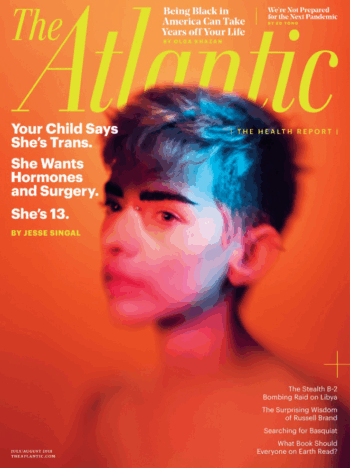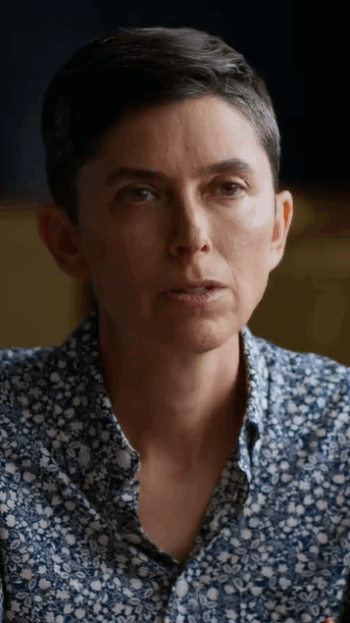Sam Feder is the director of Heightened Scrutiny, a documentary that follows transgender ACLU lawyer Chase Strangio as he argues before the Supreme Court against Tennessee’s ban on gender-affirming care for trans youth. The film explores the crucial role centrist media played in driving legislation like Tennessee’s, and the broader cultural backlash against trans rights. FAIR senior analyst Julie Hollar, who appears in the film, interviewed Feder for FAIR.

Civil rights Lawyer Chase Strangio in Heightened Scrutiny: “It’s a playbook that will effectively take a misunderstood, maligned, small minority of people and place a larger population’s anxiety of a changing world onto them.”
Julie Hollar: You previously made a documentary, Disclosure (2020), about trans representation in film and television. You’ve said Heightened Scrutiny is something like a sequel to Disclosure. What drove you to make this film?
Sam Feder: Disclosure ends with a warning about the risks of increased visibility. I first met Chase when I interviewed him for Disclosure. He explained that while representation was important, it was crucial for trans people to be pushing for actual material redistribution, and to disrupt the systems that exclude most trans people, impacting their ability to survive. Without the deep, structural change Chase suggested, I worried that we were about to face a significant backlash to the media visibility we were witnessing at the time.
The backlash was even more drastic than I could have imagined. A year after Disclosure came out, hundreds of anti trans bills were being introduced. In just three years, from 2021–2024, we went from zero states banning gender-affirming care to 24 states. Now it’s up to 27 states.
I realized very quickly that anti-trans talking points that had once been confined to right-wing news outlets were now front-page stories in the mainstream media. My colleagues, who had always been strong allies, were parroting the mainstream media, questioning the legitimacy of trans healthcare. And they felt empowered by the coverage they were reading to speak with authority when debating trans rights, because the Paper of Record was saying it, and the Wall Street Journal, and the Atlantic, and on and on and on.
So I wanted to understand this shift, and I wanted to understand why reporters did not uphold the standards of journalism in coverage of trans people. Heightened Scrutiny examines the relationship between the media’s coverage of trans rights and the anti-trans legislation we have seen balloon in the backlash since 2021.
JH: Tell me more about the role of the media that you uncovered, and your focus on the New York Times.

Atlantic (7-8/18): “”Your Child Says She’s Trans. She Wants Hormones and Surgery. She’s 13.” (He’s 22, actually.)
SF: In the film we show that there was a clear shift starting in 2018, with the cover story in the Atlantic by Jesse Singal headlined “Your Child Says She’s Trans. She Wants Hormones and Surgery. She’s 13.”
We interviewed the cover model—he was 22 years old at the time of that article! Likewise, the rest of the story is full of misinformation and fearmongering. Fast forward to 2021, and misinformation about trans people is all over the Wall Street Journal, the Chicago Tribune, the LA Times, the Washington Post.
And people started to speak up and tell these outlets that they were publishing a lot of misinformation that was dangerous and harmful. And most outlets were willing to hear that criticism, and at least tried to do somewhat better—except the New York Times. They kind of dug in their heels and took it up a notch.
In a matter of six months or so, there were seven front-page stories questioning trans people’s right to healthcare in the New York Times. In early 2023, a group of Times contributors published an open letter about the anti-trans bias that had been steadily increasing. But the Times refused to acknowledge any wrongdoing, calling it legitimate and important journalism, and still to this day they promote the voices and ideas of well-known anti-trans thinkers, and perpetuate this anti-trans narrative.
And as Chase explains in the film, in the legal realm, this unprecedented thing was happening, which is that legal briefs were citing these articles. And that is incredibly uncommon with legal briefs about medical care; you usually see citations from scientists and medical experts, you don’t see them quoting articles from newspapers. And they were doing it because that was the only place they could draw on to support their anti-trans legislation.
And it was working; they were able to pass these bills because of the anti-trans media bias that was popping up everywhere. And the New York Times was central in that. There is a scene in the film where Fox News says look, even the New York Times is questioning this medical care, so it must be really bad for adolescents.

Julie Hollar in Heightened Scrutiny: “The news media really set the political agenda in many ways…. They establish what the national discourse is.”
JH: In the film, I talk briefly about FAIR’s 2023 study of New York Times trans coverage, which showed that over the course of a year, the paper devoted more front-page articles to framing trans people as some sort of threat to others’ rights—such as cisgender women and parents—than to the coordinated assault on trans people’s rights. FAIR just published an update to that study, which shows that the Times has gotten even worse in some ways than they were before, including fewer trans sources in front-page stories about trans issues, for instance, and including just as many sources peddling unchallenged anti-trans misinformation as trans sources. How are you as a filmmaker trying to hold the Times accountable? What do you hope audiences might do in response?
SF: When people watch the film, so many are surprised to learn about the trajectory from coverage to law, and how culpable the Times has been in spreading misinformation. This link between the articles and anti-trans bills is devastating; the film shows the direct connection from article to harm.
Just like Disclosure was a field study in representation that could be applied to any marginalized community, Heightened Scrutiny is a field study that can be applied to the ways in which the media has skewed the public’s perception of all marginalized people. At the end of the day, when anyone’s right to bodily autonomy is chipped away at, everyone’s rights are.
I think this is a way to show people an example of the harm. I also hope this film is a tool for supporting those who are on the ground fighting back against the harm—medical providers, lawyers, legislators, etc.
JH: The Times is getting worse, the Supreme Court isn’t saving us. In making the film, did you come across anything that gave you hope or inspiration?
SF: I learned from people I spoke with, in particular Lewis Wallace, who talks about how hope is a practice. Hope is something we have to work for relentlessly and rigorously.
I’m inspired by Mila, the 13-year-old trans girl in the film. She’s this brilliant person, empowered and unflappable in the face of immense struggle. Watching her fight gives me hope. And watching her family showing up to support her every step of the way teaches all of us what love can look like.
There’s still so much to protect. The Skrmetti decision is devastating, but queer and trans people know that we cannot rely on the law. Our ability to survive and thrive does not begin or end with the law. We know how to take care of each other. That also gives me hope.
You know, when Zohran Mamdani won the New York City mayoral primary, I also felt real hope, witnessing New Yorkers come together and do something that seemed so impossible. I hope people will rally around trans civil rights the same way.
JH: And media did their best to push misinformation in that case, too.
SF: Yes, the Times included. And seeing people be skeptical of the media, ignore the misinformation, take action together, and do what the media try to tell us is impossible or scary or “too woke”—we need to keep doing that, and giving each other hope.

Filmmaker Sam Feder: “So many people were misled into thinking there is a legitimate debate about…whether trans people’s basic rights should be upheld, and it’s because of what they read or see in mainstream media.”
JH: What do you want people to walk away from your film with?
SF: I want people to see that the SCOTUS case is grounded in popular culture, in mainstream media and social media discourse. So many people were misled into thinking there is a legitimate debate about whether the risks of gender-affirming care outweighed the need for it, and whether trans people’s basic rights should be upheld, and it’s because of what they read or see in mainstream media. The legislation directly responds to the media climate.
Our existence is not a debate. As Jude [Ellison S. Doyle] says in the film: “Trans people are presented as one side of a debate on our lives. I hold the opinion that I exist, and you hold the opinion that I don’t.”
The outcome of this case is going to impact the constitutional rights of all people living in America. That’s lost on many people, but this is going to affect everyone’s access to privacy with their doctors.
JH: And that’s something that just wasn’t highlighted in most of the media coverage of the case, so that most people are not aware of it, based on the news reports.
SF: I absolutely think you’re right about that. There is still a lot we can protect. The fight is not over.
Heightened Scrutiny is screening in New York City at DCTV, July 18–24; in Los Angeles at Laemmle Theatres, July 26–27 and 29; and in San Francisco at the Roxie Theater, July 31 and August 2.
This content originally appeared on FAIR and was authored by Julie Hollar.